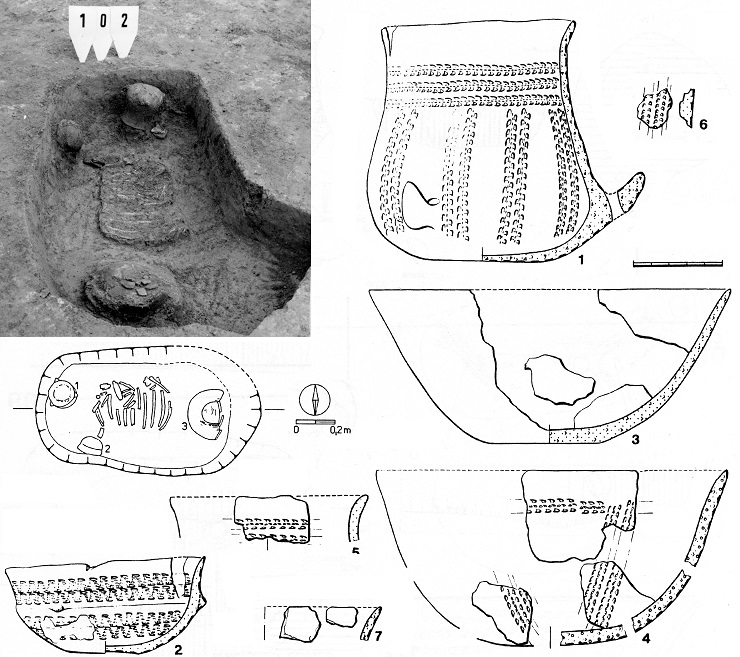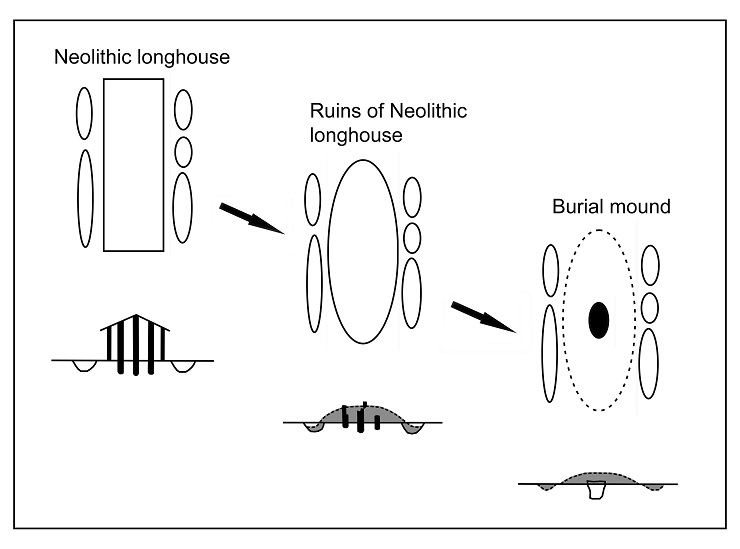A small settlement area, and especially the necropolis in Miskovice, stands unfavourably in the shadow of the famous Neolithic site in Bylany, near Kutná Hora. It is located in its immediate vicinity; spatially they are also connected by the Bylanka stream. Neolithic residents therefore had to know about each other, apparently cooperate and perhaps farm jointly and experience the other festivities. It is actually as if they were closely connected relationally, which indirectly indicates a later change of the Miskovice site into a burial ground and its addition to the settlement space in Bylany.
|
|
| The reconstruction of the settlement of the Linear Pottery culture in Miskovice; on the right there is the ruin of house No. 58, while on the left house No. 32 burned down and the most recent standing house No. 23 sits in the middle. The author of the virtual reconstruction is Štěpán Kravciv, with the editorial assistance of Petr Vavrečka. |
At the time of the Linear Pottery culture Miskovice was only a minor settlement enclave as compared to densely populated Bylany. Its duration is estimated to be cca. 75-100 years. Gradually three more houses were built there all of which also always respected the space where the previous structures stood. After leaving the settlement at the end of the Linear Pottery culture the site remained derelict for some time, but then what happened was that the living were replaced by the dead – i.e. the settlement became a burial ground. It had actually been a separate burial site of the Stroked Pottery culture that was located in the hinterland of the Bylany settlement and its two roundels.
 |
| The documentation of double-grave No. 102 in Miskovice containing the cremated remains of a woman and also a child’s skeleton, including additional vessels from the period of the Stroked Pottery culture. |
A total of 69 graves were explored there, but it is estimated that there is a higher number of them. The burials were bi-ritual – the bodies were first stored unburned, while in the next phase cremation prevailed. The distribution of the graves in the area of the defunct settlement fully respects the groundplans of the original longhouses. This can be explained in two ways: either the houses remained visible on the surface and the next generation fully respected them for some specific reason, or the graves were also located in spaces that belong to the houses but, for various reasons (e.g. erosion, tillage), they were not actually preserved till the present day.
Neolithic longhouses as a prototype of megalithic cairns represent a topic that is much discussed in the scientific literature. Burials in houses would then take on a certain symbolic role in regard to the transformation of the original meaning of the dwelling intended for the living into a space that is dedicated to the dead. It has to do also with reverence for ancestors and for the sites associated with them. After the death of an important member of the family the house could be abandoned and the building would then become the exclusive abode of the dead or eventually, perhaps, also of other members of his or her family. This could be the reason why today we can only encounter sporadic burials that take place in pits that are close by houses - the remains from the houses (or the storing of the remnants of demolished buildings) would be destroyed as a result of time and would become archaeologically elusive. A similar phenomenon – i.e. the storage of the dead in the shell of a cairn - can be seen in the subsequent Eneolithic period. Between the cairn as such and the longhouse it remains possible to look for a clue at the symbolic level. In regard to houses and graves it is also possible to observe a close link to the Near East, where the dead were buried under the floor of the houses, or at least their partial remains did stay inside the dwelling. Blending the world of the living with that of the dead therefore does have its own long tradition.
|
|
| The striking resemblance between the groundplans of the Neolithic longhouses and those of the megalithic cairns constitute a theoretical model of the transformation of a house of the living into a house of the dead. According to Midgley 2005. |
Want to learn more?
- Bradley, R. 1998. The Significance of Monuments: On the Shaping of Human Experience in Neolithic and Bronze Age Europe. London: Routledge.
- Bradley, R. 2001. Orientations and origins: a symbolic dimension to the long house in Neolithic Europe. Antiquity 75 (287): 50–56.
- Hodder, I. 1990. The Domestication of Europe: Structure and Contingency in Neolithic Societies. Oxford: Blackwell.
- Midgley, M. S. 2005. The Monumental Cemeteries of Prehistoric Europe. Stroud: Tempus Pub Limited.
- Pavlů, I. 1998. Linear Pottery Settlement Area of the Miskovice 2 Site (Distr. Kutná Hora). In Bylany Varia 1, ed. I. Pavlů, 53–82. Praha: Archeologický ústav AV ČR.
 Archeologické 3D virtuální muzeum
Archeologické 3D virtuální muzeum

.png)

